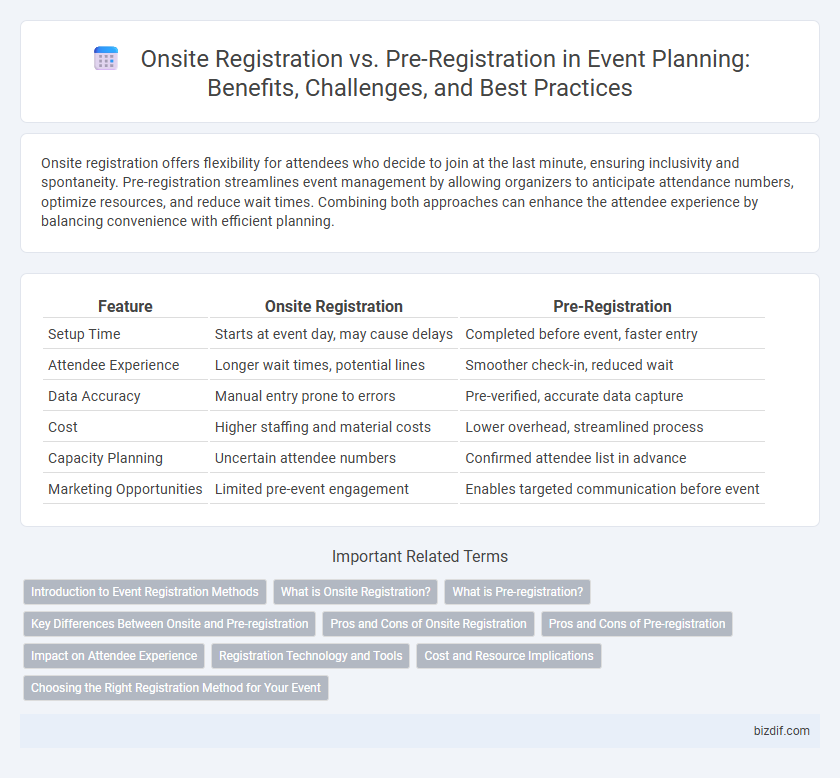Onsite registration offers flexibility for attendees who decide to join at the last minute, ensuring inclusivity and spontaneity. Pre-registration streamlines event management by allowing organizers to anticipate attendance numbers, optimize resources, and reduce wait times. Combining both approaches can enhance the attendee experience by balancing convenience with efficient planning.
Table of Comparison
| Feature | Onsite Registration | Pre-Registration |
|---|---|---|
| Setup Time | Starts at event day, may cause delays | Completed before event, faster entry |
| Attendee Experience | Longer wait times, potential lines | Smoother check-in, reduced wait |
| Data Accuracy | Manual entry prone to errors | Pre-verified, accurate data capture |
| Cost | Higher staffing and material costs | Lower overhead, streamlined process |
| Capacity Planning | Uncertain attendee numbers | Confirmed attendee list in advance |
| Marketing Opportunities | Limited pre-event engagement | Enables targeted communication before event |
Introduction to Event Registration Methods
Onsite registration allows attendees to sign up at the event location, offering flexibility but often causing longer wait times and requiring more staffing resources. Pre-registration streamlines the check-in process, enhances data collection accuracy, and helps event organizers forecast attendance more effectively. Choosing the right registration method depends on event size, type, and desired attendee experience.
What is Onsite Registration?
Onsite registration refers to the process where attendees sign up or check in for an event at the venue itself, often on the day of the event. It allows for last-minute entries and immediate updates to event attendance records, enhancing flexibility for both organizers and participants. This method requires sufficient staffing and technology to manage queues efficiently and provide a smooth attendee experience.
What is Pre-registration?
Pre-registration is the process where attendees sign up for an event online or through other remote methods before the event date, ensuring their participation is secured in advance. This approach streamlines event management by reducing check-in times and enabling organizers to anticipate attendance numbers more accurately. Pre-registration often includes payment processing, personalized badges, and tailored communication, enhancing the overall attendee experience.
Key Differences Between Onsite and Pre-registration
Onsite registration involves participants signing up at the event location, providing flexibility for last-minute attendees but often causing longer wait times and logistical challenges. Pre-registration requires attendees to register online before the event, enabling smoother check-ins, accurate headcounts, and better resource allocation. Event planners prefer pre-registration for improved planning efficiency and enhanced attendee experience, while onsite registration serves as a backup for unexpected participants.
Pros and Cons of Onsite Registration
Onsite registration allows event organizers to accommodate last-minute attendees, providing flexibility and the opportunity to capture additional participants who decide to join spontaneously. However, it can lead to longer wait times, increased staffing needs, and potential logistical challenges that may disrupt the event flow. While onsite registration fosters inclusivity, it often requires more resources and careful management to ensure a smooth check-in experience.
Pros and Cons of Pre-registration
Pre-registration streamlines event entry by reducing wait times and improving attendee flow, enhancing overall satisfaction and operational efficiency. This method allows organizers to collect valuable data in advance, enabling better resource allocation and targeted communication. However, pre-registration may deter spontaneous attendees and requires robust technology infrastructure to manage data securely and effectively.
Impact on Attendee Experience
Onsite registration offers flexibility and spontaneity, attracting last-minute attendees but often resulting in longer wait times and potential overcrowding, which can negatively impact the attendee experience. Pre-registration streamlines check-in processes, reduces queues, and enables organizers to better anticipate attendance numbers, significantly enhancing overall satisfaction. Implementing a hybrid approach with efficient onsite options can balance convenience and structure, ensuring a positive and seamless event experience.
Registration Technology and Tools
Onsite registration offers flexibility using portable kiosks and mobile scanners, enabling quick badge printing and real-time attendee tracking. Pre-registration leverages online platforms and integrated CRM systems to streamline data collection and payment processing before the event, reducing wait times. Advanced registration technologies like QR code scanning, biometric authentication, and automated check-in kiosks optimize attendee flow and enhance the overall event experience.
Cost and Resource Implications
Onsite registration typically incurs higher costs due to the need for additional staff, equipment, and materials to manage last-minute sign-ups, increasing resource allocation during the event. Pre-registration reduces these expenses by streamlining headcounts, minimizing onsite staffing needs, and allowing for better inventory management of badges and materials. Efficient pre-registration leads to cost savings and optimized use of human and logistical resources while onsite registration demands more flexible, often unpredictable resource deployment.
Choosing the Right Registration Method for Your Event
Choosing between onsite registration and pre-registration depends on the event size, budget, and attendee experience goals. Pre-registration streamlines check-in, reduces wait times, and improves data accuracy, making it ideal for large-scale events. Onsite registration offers flexibility for last-minute attendees but may increase staffing needs and potential delays.
Onsite registration vs Pre-registration Infographic

 bizdif.com
bizdif.com